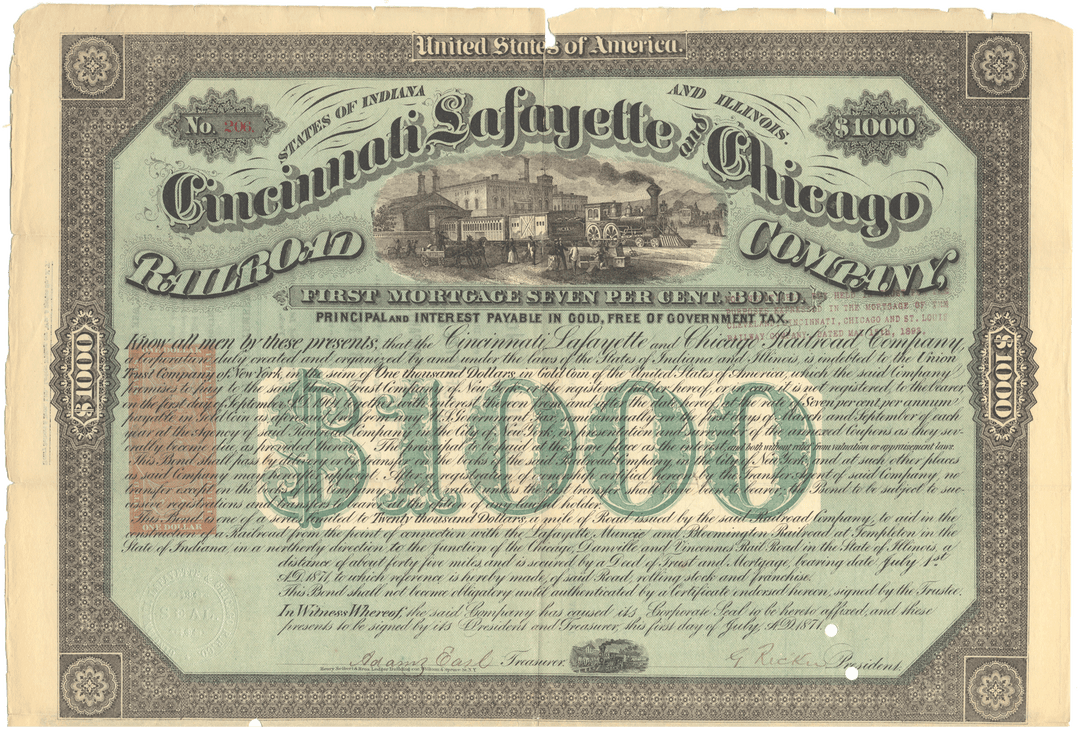
Cincinnati, Lafayette and Chicago Railroad Company (Signed by Adams Earl)
- Guaranteed authentic document
- Orders over $75 ship FREE to U. S. addresses
You will receive the exact certificate pictured
Over 150 years old
Consolidated mortgage gold bond
March 1, 1873
Issued, canceled
Henry Seibert & Bros.
Hand signed
16 3/4" (w) by 16 1/2" (h)
Signed by Adams Earl.

Adams Earl, of La Fayette, Indiana, was born April 20, 1819, in Fairfield County, Ohio, and was the youngest of a family of fifteen children of Nehemiah and Rebecca Earl.
Earl passed his younger days on the family farm, and during the winter of 1836-'37 came with his parents to Tippecanoe County, Indiana, settling on the Wea Plains. He was employed in breaking prairie and farming. In 1840 he commenced constructing flat-boats on the Wabash River, loading them with products from the Wea Plains and taking them to New Orleans. In 1848 he moved to La Fayette, Indiana, and started in a general merchandise business with James G. Carnahan, under the firm name of Carnahan & Earl. He disposed of his interest to his partner in 1853, and embarked in the wholesale grocery business. The same year, in company with Henry Jacobs, of Rainsville, Warren County, Indiana, he conducted a general merchandise store for several years. Near the close of 1853 he formed a partnership with Moses Fowler in the wholesale grocery trade, under the name of Fowler & Earl. In 1857, they added to their business that of banking, opening the Indiana Bank, which was afterward merged into the La Fayette Branch of the State of Indiana, afterward known as the National State Bank of La Fayette.
During the above period Earl continued as the active manager of the wholesale grocery house. In 1857, Henry C. Bruce was admitted as partner, under the name of Fowler, Earl & Bruce, which continued until 1860, when Earl purchased the other interests and associated himself with William Hatcher, of La Fayette, the firm being Earl & Hatcher. Up to this time the grocery business had been conducted in rooms in the Purdue block, on Second, corner of Columbus Street, but it had become so large they had to obtain more space. Accordingly, in 1865, they erected the large stone-front building known as the Earl & Hatcher block, on Third, corner of South street, and early in 1866 moved their stock and office into it. In February, 1869, Hatcher died, and in April following Chalres W, Bangs, of La Fayette, was admitted as partner, the firm name becoming Adams Earl & Co. In 1876, Morell J. Earl, the only son of Adams Earl, was admitted into the house, and continued an active member until his death, June 28, 1879.
In 1860, Earl engaged with others as J.H. Telford & Co., in pork and beef packing, and built a spacious packing-house in La Fayette. They continued for six years, doing a large trade. In 1862, Earl was a partner in the firm of Culbertson, Blair & Co., of Chicago, Illinois, and engaged in a general commission business and in packing pork and beef. They built a large packinghouse in that city and carried on an extensive and profitable trade until the dissolution of the partnership in 1867. In 1862, Earl and Hatcher became associated with A. J. Carnahan, under the firm name of Carnahan, Earl & Co., in the wholesale boot and shoe trade, which they continued for three years. That same year, Earl became a member of the wholesale dry goods house of Curtis, Earl & Co. continuing in it until 1869, when he disposed of his interest to this partners.
In 1869 an enterprise was commenced by La Fayette citizens to secure an east and west railroad, running from Muncie, Indiana, through LaFayette, to Bloomington, Illinois. From its first inception Earl took and active interest in the project. At the first meeting he was elected a director of the company, and by the directors he was elected president. He served in this capacity three years, during which time the western division of the road was completed and put in operation.
In 1870 the Cincinnati, La Fayette & Chicago Railroad Company was organized to construct and operate a railroad from La Fayette to Kankakee, Illinois, there to connect with the Illinois Central for Chicago. This road was owned by Earl, Fowler and Gustavus Ricker, with Earl being president, general manager and builder. This section of railroad eventually became part of the Cincinnati, Indianapolis, St. Louis & Chicago Railroad, and was known as the Kankakee line, the shortest line to Chicago.
In 1877, by purchasing Fowler's bonds and stock, Earl secured a controlling interest in the property, and to its management gave his careful and constant attention. In November, 1879, Earl disposed of his controlling interest in this property to a party of Boston capitalists, and retired from its management. This road crossed the Kankakee River at Waldron, Illinois, where in 1874, Earl, in company with others, constructed large buildings for the storage of 35,000 tons of ice. This was a joint stock company, called the Kankakee Crystal Ice Company, of which Earl was president.
Earl Park is a town located in Richland township, Benton County, Indiana, was named for Adams Earl. Fowler, Indiana was named after his business associate, Moses Fowler.
Additional Information
Certificates carry no value on any of today's financial indexes and no transfer of ownership is implied. All items offered are collectible in nature only. So, you can frame them, but you can't cash them in!
All of our pieces are original - we do not sell reproductions. If you ever find out that one of our pieces is not authentic, you may return it for a full refund of the purchase price and any associated shipping charges.





